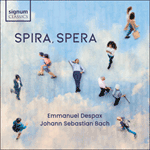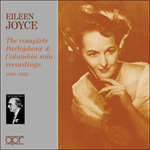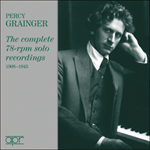The passing of the age of deriding the transcription allows us to be joyful at one composer’s enthusiasm and understanding of the works of another. Transcription, in any case, has been a valid way of music making in almost every generation of the history of Western music, and it cannot be simply assumed that the gramophone has replaced it as a likely means of disseminating music not often encountered in live performance. In the case of his very careful arrangements of seven of Bach’s greatest organ works, it should be mentioned that Liszt was at the forefront of the revival of serious study of polyphonic organ playing and the independent study of the pedalboard in order to restore the neglected Bach to his public. Liszt also published an edition of Bach’s organ music in which he also added two other pieces of Bach in his own transcription for the organ. The
Sechs Präludien und Fugen für die Orgel-pedal und -manual von Johann Sebastian Bach—Für das Pianoforte zu zwei Händen gesetzt von Franz Liszt were the first in a long series of Bach transcriptions by many of the great pianists and pianist-composers which extended from the mid-nineteenth century to our own times through such names as Brahms, Tausig, Saint-Saëns, d’Albert, Busoni, Reger, Grainger, Rachmaninov and Bartók. Apart from the obvious purpose of communicating Bach’s music through the instrument with which these composers felt most comfortable, there is also a sense of greater satisfaction at being able to exploit the piano for its innate good qualities in a way that simply playing Bach’s harpsichord and clavichord works on the piano seldom produces. Doubling bass notes in octaves, for example, is present in virtually every piano piece in the literature, and the use of the sustaining pedal not just as a colouring device, but also to hold notes which the fingers cannot keep depressed, and the consequent inevitable blurring of some counterpoint, is equally ubiquitous. Now, the organ works of Bach, especially, are familiar to us from acoustical surroundings in which, willy-nilly, something like the effect of a sustaining pedal is achieved, and the power of the pedal organ is usually such as to make the lowest voice of the texture disproportionately strong. In his transcriptions, Liszt carefully doubles the pedal part in octaves wherever practical and appropriate, but otherwise alters Bach’s text almost never, aside from some necessary octave transpositions to allow the hands to reach all the voices, and the fleshing out of a few rhetorical chords. He adds no tempo directions, dynamics or phrasing marks of any sort. As to Bach’s originals, the question of dating their origin is still unsettled, although most of them date from his time in Weimar. Some were revised later in Cöthen, and at least two of them (E minor and B minor) probably date from his time in Leipzig. It doesn’t really matter; all these works are the mature Bach at his best extended style, and the variety of idea and structure remains astounding to us all. In the playing of the transcriptions it seems best to proceed as Liszt probably did, and to study them on the organ in order not to be tempted into spurious pianistic effects—although the problem of memorising them in versions with and without pedalboard becomes acute. It is worth trying to reproduce the effects of eighteenth-century registration, articulation and ornamentation wherever feasible, and, as with all of Liszt’s literal transcriptions, it is important to go to the best available source of the original in order to check the text—Liszt was generally very scrupulous about the matter, so there are only one or two small corrections to make.
from notes by Leslie Howard © 1991
Puisque la mode de se moquer de la transcription est passée, nous pouvons nous réjouir de l’enthousiasme et de la perception d’un compositeur pour les œuvres d’un autre. De toute façon, la transcription a été un moyen accepté d’écrire de la musique dans presque toutes les générations de l’histoire de la musique occidentale, et il n’est pas possible d’assumer tout simplement que le phonographe l’a remplacée comme moyen vraisemblable de faire connaître la musique que l’on n’entend pas très souvent dans les concerts. En ce qui concerne les arrangements très consciencieux de sept des plus célèbres œuvres de Bach pour orgue, il faut mentionner le fait que Liszt se trouvait au tout premier plan de la reprise de l’étude sérieuse de l’orgue polyphonique et de l’étude indépendante de la pédale afin de rendre Bach, négligé à l’époque, à son public. Liszt a publié aussi une édition de la musique pour orgue de Bach dans laquelle il a ajouté deux autres morceaux de Bach qu’il avait transcrits lui-même pour l’orgue. Les
Sechs Präludien und Fugen für die Orgel-pedal und -manual von Johann Sebastian Bach—Für das Pianoforte zu zwei Handen gesetzt von Franz Liszt furent les premiers d’une longue série de transcriptions de Bach par un grand nombre de célèbres pianistes et compositeurs-pianistes qui, du milieu du dix-neuvième siècle à nos jours, passent par Brahms, Tausig, Saint-Saëns, d’Albert, Busoni, Reger, Grainger, Rachmaninov et Bartók. A part l’intention évidente de communiquer la musique de Bach au moyen de l’instrument avec lequel ces compositeurs se trouvent le plus à l’aise, il y a aussi un sentiment d’une plus grande satisfaction quand il est possible de tirer parti des excellentes qualités naturelles du piano de cette façon, alors que jouer simplement les œuvres de Bach pour le clavecin et le clavicorde ne le permet pas. Le redoublement des notes basses dans les octaves, par exemple, se trouve dans virtuellement tous les morceaux pour piano dans la littérature, et il en est de même pour l’utilisation de la pédale tenue non pas simplement comme un moyen d’ajouter de la couleur, mais aussi pour tenir des notes que les doigts ne peuvent continuer à tenir, avec l’inévitable conséquence d’un brouillage léger du contrepoint. De nos jours, nous connaissons les œuvres pour orgue de Bach dans un cadre acoustique où, qu’on le veuille ou non, un effet ressemblant à la pédale tenue est effectué et la puissance du pédalier est généralement telle qu’elle donne à la voix la plus basse de la texture une force hors de proportion. Liszt, dans ses transcriptions, double avec soin la partie de la pédale en octaves partout où cela est possible et pratique, mais autrement ne change jamais rien au texte de Bach, à part quelques transposition d’octaves nécessaires pour permettre aux doigts d’atteindre toutes les voix et pour donner plus d’ampleur à quelques accords rhétoriques. Il n’ajoute aucune direction de tempo, de dynamique ou de phrasé. En ce qui concerne les œuvres originales de Bach, la question de mettre une date sur leur origine n’a pas encore été résolue, bien que la plupart d’entre elles datent de la période où Bach était à Weimar. Certaines furent révisées plus tard à Cöthen, et deux d’entre elles au moins (mi mineur et si mineur) datent probablement de sa période à Leipzig. Cela n’a vraiment pas grande importance; toutes ces œuvres sont du Bach en pleine maturité et de son style le plus étendu, et la variété d’idées et de structure continue à nous surprendre tous. En exécutant les transcriptions, il semble préférable d’imiter la façon dont Liszt procédait probablement et de les étudier à l’orgue afin de ne pas être tenté d’effectuer de faux effets pianistiques—bien que les apprendre par cœur dans des versions avec et sans pédale devienne un gros problème. Cela vaut la peine d’essayer de reproduire les effets de registre, articulation et ornementation du dix-huitième siècle partout où cela est possible et, comme pour toutes les transcriptions littérales de Liszt, il est important de remonter à la meilleure source de l’original que l’on puisse trouver afin de vérifier le texte—Liszt était généralement très scrupuleux à ce sujet, de sorte qu’il n’y a qu’une ou deux petites corrections à faire.
extrait des notes rédigées par Leslie Howard © 1991
Français: Alain Midoux
Nachdem die Ära vorüber ist, in der jegliche Transkription verlacht wurde, dürfen wir uns heute freuen über den Enthusiasmus und das Verständnis, das ein Komponist für die Werke eines Anderen aufbringt. Immerhin war Transkription in fast jeder Phase der Geschichte westlicher Musik eine wirksame Methode, Musik zu machen, und man kann nicht einfach unterstellen, daß das Grammophon sie als Mittel der Verbreitung selten aufgeführter Werke ersetzt habe. Angesichts der mit höchster Sorgfalt ausgeführten Arrangements von sieben der bedeutendsten Orgelwerke Bachs sei erwähnt, daß sich Liszt in vorderster Front für das Wiederaufleben ernsthafter Auseinandersetzung mit polyphonem Orgelspiel und für das unabhängige Erlernen des Pedals einsetzte, mit dem Ziel, den lange vernachlässigten Bach wieder seinem Publikum nahezubringen. Außerdem veröffentlichte Liszt eine Ausgabe von Bachs Orgelmusik, der er zwei weitere, von ihm für die Orgel .0transkribierte Stücke von Bach hinzufügte. Die
Sechs Präludien und Fugen für die Orgel -pedal und -manual von Johann Sebastian Bach—Für das Pianoforte zu zwei Händen gesetzt von Franz Liszt waren die ersten einer langen Reihe von Bach-Transkriptionen, die von zahlreichen bedeutenden Pianisten und Komponisten, darunter bekannte Namen wie Brahms, Tausig, Saint-Saëns, d’Albert, Busoni, Reger, Grainger, Rachmaninow und Bartók, ab Mitte des 19. Jahrhunderts bis in unsere Zeit vorgenommen wurden. Zu dem offenkundigen Zweck, Bachs Musik über das Instrument zu vermitteln, mit dem sich diese Komponisten am wohlsten fühlten, kommt ein Gefühl erhöhter Befriedigung hinzu, die wesensmäßigen Vorzüge des Klaviers nutzen zu können—ein Gefühl, das sich selten einstellt, wenn man Bachs Werke für Cembalo oder Klavichord einfach so auf dem Klavier spielt. Oktavisches Verdoppeln von Baßnoten ist beispielsweise in praktisch jedem Klavierstück des Repertoires vertreten. Gleichermaßen allgegenwärtig sind die Verwendung des Tonhaltepedals nicht nur als klangfärberisches Mittel, sondern auch zum Halten von Tönen, wenn die Finger nicht auf Dauer die Tasten drücken können, sowie das dadurch unvermeidliche Verwischen des Kontrapunkts. Nun sind uns insbesondere die Orgelwerke Bach aus einem akustischen Milieu vertraut, in dem ein Effekt wie der des Tonhaltungspedals ohne Umstände zu erzielen ist, und die Besonderheit der Pedalorgel besteht gewöhnlich darin, daß die tiefste Stimme eines Gefüges unverhältnismäßig laut erscheint. In seinen Transkriptionen verdoppelt Liszt, wann immer es praktikabel und angemessen ist, mit Bedacht den Pedalpart in Oktaven. Ansonsten ändert er Bachs Vorlage fast nie, von ein paar notwendigen Oktavtranspositionen abgesehen, damit die Hände alle Stimmen erreichen können, und der üppigeren Gestaltung einiger rein rhetorischer Akkorde. Er fügt weder Tempo-, noch Dynamikangaben oder Phrasierungsvorschriften hinzu. Um noch einmal auf Bachs Originale zurückzukommen: Die Frage ihrer Datierung ist nach wie vor ungelöst, bis auf die Tatsache, daß die meisten aus seiner Weimarer Zeit stammen. Einige wurden später in Köthen überarbeitet, und mindestens zwei (e-Moll und b-Moll) entstanden vermutlich, als er in Leipzig tätig war. Aber das ist eigentlich unerheblich; wichtig ist, daß es sich ausnahmslos um Werke der Reifezeit Bachs im besten, ausgeprägtesten Stil handelt, und die Mannigfaltigkeit von Idee und Struktur ist und bleibt für jeden von uns erstaunlich. Beim Spielen der Transkriptionen erscheint es angebracht, so vorzugehen, wie Liszt es vermutlich getan hat: Man sollte sie auf der Orgel einüben, damit man nicht zu unnützen pianistischen Effekten verleitet wird—allerdings stellt sich da das Problem, sich zwei Versionen mit und ohne Pedalpart zu merken. Wo dies machbar ist, lohnt der Versuch, Registereffekte, Artikulation und Verzierungen des 18. Jahrhunderts zu reproduzieren. Außerdem kommt es wie bei allen textgetreuen Transkriptionen von Liszt darauf an, sich mit der besten verfügbaren Quelle zu befassen, um die Spielvorlage zu überprüfen—Liszt war im allgemeinen sehr ordentlich, darum sind nur eine oder zwei kleine Korrekturen anzubringen.
aus dem Begleittext von Leslie Howard © 1991
Deutsch: Anne Steeb/Bernd Müller


 Liszt: Complete Piano Music
Liszt: Complete Piano Music Spira, spera - Bach transcriptions
Spira, spera - Bach transcriptions Eileen Joyce - The complete Parlophone & Columbia solo recordings
Eileen Joyce - The complete Parlophone & Columbia solo recordings Percy Grainger - The complete 78-rpm solo recordings
Percy Grainger - The complete 78-rpm solo recordings
